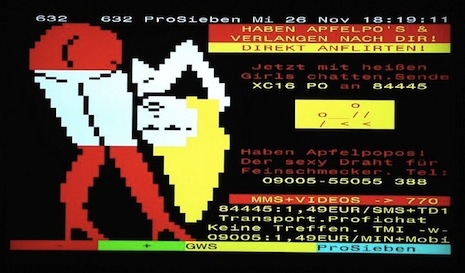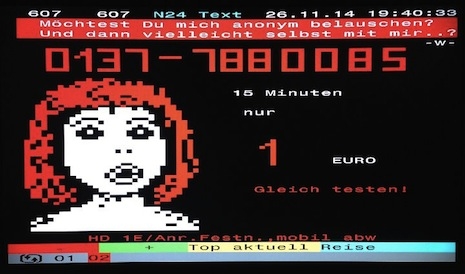
This lady has an “Apfelpo”—that is, a butt like an apple
These images require some clarification. Roughly a decade before the rise of the World Wide Web in 1995, citizens of Germany and Austria (I’m not sure where else) could access through their TV sets a digital mode of information dissemination known as Teletext, a system that had been developed in the U.K. during the 1970s. If you had the right kind of TV with the right kind of remote control—and they weren’t uncommon at all, loads of German speakers know about this—you could switch your TV into an interactive mode where you could dial up certain basic, updated information such as headlines, weather information, sports scores, traffic updates, and even flight departures and arrivals at airports.
Many channels (ZDF, 3sat, etc.) have their own Teletext systems, and by punching in “100” you could get the homepage; other 3-digit numbers would be displayed on the screen for other forms of information, and if you typed in one of those numbers, you would get a page dedicated to this or that story or perhaps a list of cities and temperatures or the like. What was charming about it was that it was pretty resolutely low-bit—the screens would often use a crude form of ASCII art for logos. Furthermore, the system scarcely seemed to change over time—during an era in which incredible resources were being thrown into improving and maximizing browser technologies, poky old Teletext just stayed the same year after year. You could look at a Teletext display from today, and it would look about the same as an equivalent display from 1990. The fact that Europe was so far ahead of the U.S. on such matters was not lost on me, I would sometimes tell Americans, prone to gushing about U.S. tech superiority, about it.
I’ve spent a lot of my life in Austria, particularly in the pre-WWW years of 1992 to 1995, when I lived in Vienna full-time (although I didn’t own a TV set), so all of my associations with Teletext are uniformly from that country. Here’s a “normal” Teletext screen from ORF, the Austrian news organization, with headlines (Schlagzeilen) about military helicopters (101), terror arrests in France (127), Austrian chancellor Werner Faymann (115), a demonstration in Leipzig (133), something about the Swiss Franc (117), and Argentina (134).

Every one of those numbers will lead to a “story” that is parceled out in screens of no more than 12 or 15 lines at a time, and maybe 35 characters across. It’s a little like trying to read a newspaper on a clam phone—it’ll do in a pinch, but not really satisfying. Useful as Teletext may be—and it is useful—it’s also unremittingly boring. Once you find out about the immediate news you were seeking, there’s almost no way to spend more than about 10 minutes fiddling with Teletext on the TV.
I didn’t know until today that there exist XXX pages on Teletext, when some of them popped up on a blog I sometimes look at, text-mode, which is dedicated to ASCII art and anything that has a remote resemblance to pixelated art (certain kinds of weaved tapestries, for instance).
I found these Teletext pages funny, and I thought you might as well. If it’s not entirely obvious, these are ads for phone sex workers

I suspect that the numerical string “80085” does not require translation, but for those of you without a calculator, it’s “boobs.”

“AV-Spass” = “AV fun,” where “AV” means “Analverkehr” or nevermind…

“Dauergeile” means “constantly horny,” “stute” means “mare,” so it’s like you’re boning horny mares. Eesh.
More after the jump…





